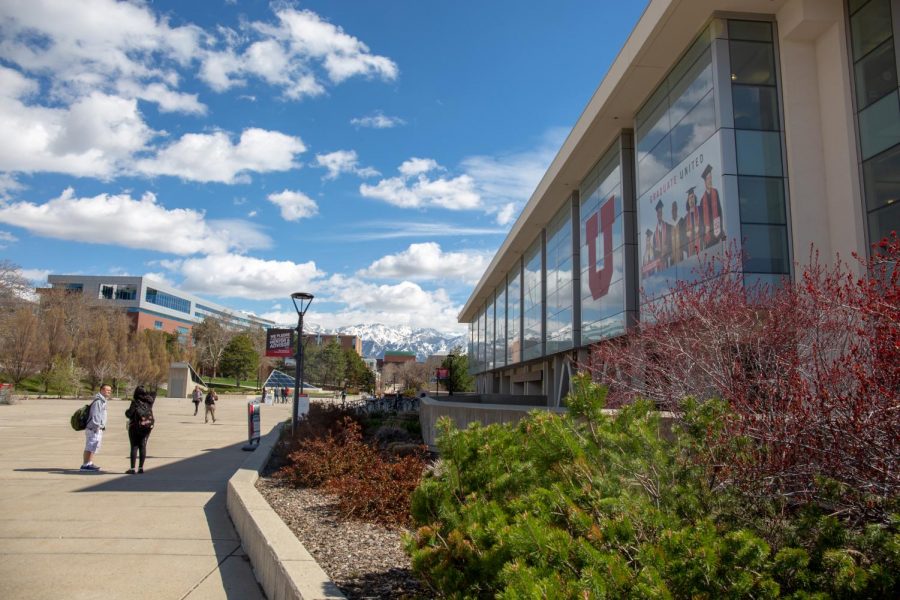The Reasoning and Effectiveness of Moving to Online Classes to Prevent Spread of COVID-19
“Students at the U and across the nation are struggling. It is important to take care of ourselves, remain calm, have compassion for others and do our part in slowing the spread of the virus.” | Chronicle archives.
March 12, 2020
As the Daily Utah Chronicle previously reported, state leaders held a press conference Thursday morning to announce measures to slow the spread of COVID-19, or novel coronavirus, inside Utah. Among those measures was the transition of University of Utah classes to an online format for the remainder of the semester.
Lt. Gov. Spencer Cox began the press conference by saying that research has shown preemptive measures control the spread of disease more effectively than reactive measures can.
When cases of COVID-19 have been reported in the community, which is the case with the U, the CDC says that education administrators should consider temporarily suspending classes and other campus activities as a method to slow or even potentially stop the spread of disease in the community.
The agency recommends that, if schools take this step, they find ways to provide instruction in other settings that are not face-to-face, maintain housing and meal plans, and discourage people affiliated with the institution from socializing elsewhere. The U’s moves conform to those CDC recommendations.
Closing a school is a form of social distancing, which the CDC recommends. The agency defines social distancing as “remaining out of congregate settings, avoiding mass gatherings, and maintaining distance (approximately 6 feet or 2 meters) from others when possible.”
Many other Utah and U.S. colleges and universities have moved instruction to virtual platforms after spring break, arguing that the risk of having students return to campus after many of them have traveled is simply too great.
“Colleges are closing campuses left and right because they’re worried — correctly — about spring break, and the potential for students to travel, become infected and then spread the disease among other students and faculty in the next few weeks,” wrote Aaron Carroll for the New York Times. Carroll is a pediatrician and health policy expert at Indiana University.
Other experts have also advocated for schools to close. Science—one of the world’s leading academic journals—published an interview this week with Nicholas Christakis as part of its science news coverage. In the interview, Christakis—who is a physician and a social scientist working at Yale—called closing schools “one of the most powerful nonpharmaceutical interventions that we can deploy.”
In the interview, which focused on K-12 schools, he explained that closing a school after someone related to the organization becomes ill does help, but that closing a school before the disease reaches it is even better at preventing the spread of disease inside it and in the surrounding community.
Christakis told NPR in an interview that, “If you wait for the case to occur [in your school], you still have wound up closing the school, but now you’ve missed the opportunity to have the real benefit that would have accrued had you closed the school earlier.”
Transitioning to online instruction does come with challenges. Some students may not have reliable access to computers or the internet. Some classes require in-person instruction, like labs. Some students have additional requirements — like international students and those with Pell Grants or Work-Study.
According to reporting by the New York Times, government agencies are acting to make the transition less difficult for students. The Department of Education is offering universities more flexibility to deal with disease or the risk of it spreading. They are also allowing students with Pell grants or who work for universities as part of the Federal Work-Study program to maintain their financial aid if they can’t return to campus.
The Immigration and Customs Enforcement Agency has also granted flexibility for international students. Under normal circumstances, online courses often do not meet requirements for international students to maintain their visas. This will no longer be the case, as long as universities moving to virtual instruction notify the agency within 10 days.
According to CDC guidance, universities should work with local health officials to determine when in-person instruction should resume.
Utah leaders echoed the CDC and other experts at the press conference announcing the changes.
Governor Gary Herbert said the decisions made by the state, including transitioning the U to online instruction, are based on good science and will help protect the state. “It’s better to be early than it is to be too late,” he said. He called the measures a “speedbump” to slow down the spread of the disease. “We are hoping for the best, but preparing for the worst.”
Cox called the measures the only way to prevent overwhelming the state’s health care systems.
University president Ruth Watkins said that the U’s restrictions and transition to online classes represent “doing our part to slow the spread” of coronavirus.
Editor’s note: Signs and symptoms of COVID-19 include fever, dry cough, tiredness and shortness of breath. These symptoms are believed to occur between two and 14 days after a person is exposed to the disease. If you have these symptoms and have recently come into contact with a person who is known to have COVID-19, or if you have recently traveled to an area with community spread of the disease, you should call your doctor. Areas with community spread of COVID-19 are believed to include China, South Korea, Italy, Iran and Seattle. If you do not have a doctor who you visit regularly, please call the Utah Coronavirus Information Line at 1-800-456-7707 or the University of Utah Health hotline at 801-587-0712. Do not go to a healthcare facility without first making arrangements to do so.








